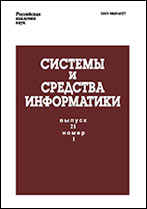|
Visual reasoning modeling in a functional hybrid intelligent system
A. V. Kolesnikovab, S. V. Listopadb, S. B. Rumovskayab, V. I. Danishevskya
a Immanuel Kant Baltic Federal University, 14 A. Nevskogo Str., Kaliningrad 236041, Russian Federation
b Kaliningrad Branch of the Federal Research Center "Computer Science and Control" of the Russian Academy of Sciences, 5 Gostinaya Str., Kaliningrad 236000, Russian Federation
Abstract:
Hybrid intelligent systems have been successfully used to solve the problems with high modeling complexity due to combination of multiple methods of simulation of human intellectual activity and compensation of some methods' shortcomings by advantages of the other. Most hybrid intelligent systems are based on the interaction of elements of the symbolic-logical model of knowledge, which limits their opportunities in comparison with the groups of experts, operating character-logical and visual-imaginative knowledge. Modeling of the collective visual-imaginative reasoning is proposed for implementation in a new class of intelligent systems — hybrid intelligent systems with heterogeneous visual field. To implement such reasoning, the formalized model of visual languages, based on the concept of the semiotic system by D. A. Pospelov, and the principles of their combination in the heterogeneous visual field are proposed.
Keywords:
hybrid intelligent system; heterogeneous visual field; visual language; semiotic system.
Received: 15.06.2016
Citation:
A. V. Kolesnikov, S. V. Listopad, S. B. Rumovskaya, V. I. Danishevsky, “Visual reasoning modeling in a functional hybrid intelligent system”, Sistemy i Sredstva Inform., 26:4 (2016), 100–113
Linking options:
https://www.mathnet.ru/eng/ssi493 https://www.mathnet.ru/eng/ssi/v26/i4/p100
|

| Statistics & downloads: |
| Abstract page: | 196 | | Full-text PDF : | 88 | | References: | 48 |
|




 Contact us:
Contact us: Terms of Use
Terms of Use
 Registration to the website
Registration to the website Logotypes
Logotypes








 Citation in format
Citation in format 